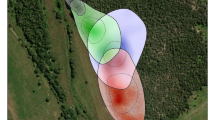Summary
-
1.
We investigated the problem of how members of the microchiropteran bat species Hipposideros speoris that live in a true cave clock their flight activity rhythms in the absence of time cues.
-
2.
The bats become restless well in advance of sunset and then fly towards the cavemouth to sample light.
-
3.
We investigated whether each bat roosting 40 m from the cave entrance must sample outside light levels for itself in order to emerge at the appropriate time. Three captive bats were tested and each began activity when the conspecifics left the cave in the evenings.
-
4.
In another series of experiments a solitary bat was held captive in a solitary cave for 50 days and its circadian rhythm was recorded. In the absence of other conspecifics the circadian rhythm ‘free ran’ with a period shorter than 24 h.
-
5.
We concluded from the results of our studies that there exists a clear-cut case for social synchronization of the circadian rhythms of this cave-dwelling bat.
Similar content being viewed by others
References
Bovet J, Oertli EF (1974) Free-running circadian activity rhythms in free-living beaver (Castor canadensis). J Comp Physiol 92:1–10
Buenning E (1973) The physiological clock (revised 3rd English ed). Springer, Berlin Heidelberg New York
Crowley M, Bovet J (1980) Social synchronization of circadian rhythms in deer mice (Peromyscus maniculatus). Behav Ecol Sociobiol 7:99–105
Erkert HG (1978) Sunset-related timing of flight activity in neotropical bats. Oecologia 36:59–67
Gwinner E (1966) Periodicity of a circadian rhythm in birds by species-specific song cycles (Aves, Fringillidae: Carduelis spinus, Serinus serinus). Experientia 22:765–766
Lohmann M, Enright JT (1967) The influence of mechanical noise on the activity rhythms of finches. Comp Biochem Physiol 22:289–296
Marimuthu G, Subbaraj R, Chandrashekaran MK (1978) Social synchronization of the activity rhythm in a cave-dwelling insectivorous bat. Naturwissenschaften 65:600
Pittendrigh CS, Minis DH (1964) The entrainment of circadian oscillations by light and their role as photoperiodic clocks. Am Nat 98:261–294
Subbaraj R, Chandrashekaran MK (1977) ‘Rigid’ internal timing in the circadian rhythm of flight activity in a tropical bat. Oecologia 29:341–348
Subbaraj R, Chandrashekaran MK (1978) Pulses of darkness shift the phase of a circadian rhythm in an insectivorous bat. J Comp Physiol 127:239–243
Twente JR (1955) Some aspects of habitat selection and other behaviour of cavern-dwelling bats. Ecology 36:706–732
Voûte AM, Sluiter JW, Crimm MP (1974) The influence of the natural light-dark cycle on the activity rhythm of pond bats (Myotis dasycneme Boie, 1825) during summer. Oecologia 17:221–243
Wever RA (1979) The circadian system of man. Springer, Berlin Heidelberg New York
Author information
Authors and Affiliations
Additional information
Dedicated to Professor Erwin Buenning on the occasion of his 75th birthday
Rights and permissions
About this article
Cite this article
Marimuthu, G., Rajan, S. & Chandrashekaran, M.K. Social entrainment of the circadian rhythm in the flight activity of the microchiropteran bat Hipposideros speoris . Behav Ecol Sociobiol 8, 147–150 (1981). https://doi.org/10.1007/BF00300827
Received:
Accepted:
Issue Date:
DOI: https://doi.org/10.1007/BF00300827




